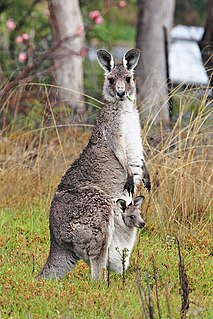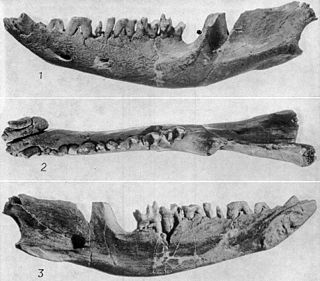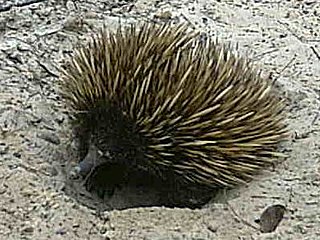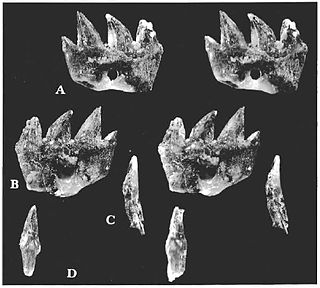This article relies largely or entirely on a single source .(August 2015) |
The Edmontonian was a North American faunal epoch occurring during the Late Cretaceous, lasting from approximately 70 to 68 million years ago.
This article relies largely or entirely on a single source .(August 2015) |
The Edmontonian was a North American faunal epoch occurring during the Late Cretaceous, lasting from approximately 70 to 68 million years ago.
In southern North America, little changed in the transition from the Judithian to the Edmontonian. [1] However, the northern biome experienced a general trend in reduction of centrosaurines, with leaving Pachyrhinosaurus as one of the few surviving species. [2] Likewise among lambeosaurs, only the single genus Hypacrosaurus remained. [3] Inland faunas of the age are distinguished by a Saurolophus - Anchiceratops association while more coastal areas were characterized by Pachyrhinosaurus and Edmontosaurus . [3] Pachyrhinosaurus occurred as far north as Alaska. [3] "Archaic" elements such as hypsilophodonts like Parksosaurus and the "(re)appearance" of basal neoceratopsians like Montanoceratops begin characterizing inland faunas. [3] Paleontologist Thomas M. Lehman described the Edmontonian Arrhinoceratops as a likely ancestor for the Lancian Triceratops . [3]
Ecological disturbance brought them to an end during the Edmontonian. [4] Relative sea levels fell very rapidly due to the Laramide orogeny. [4] Opportunistic generalist herbivores filled the vacated niches that were once filled by a diverse number of specialist forms. [4] The newly formed ecosystems tended to be dominated by a single herbivorous species each. [4] The new dominant herbivores were usually less ornamented and probably represent "survivors from indigenous lineages" rather than immigrants from other areas. [4] Gradually however "relict" dinosaurs such as protoceratopsids and sauropods began expanding into lower altitude areas as sea-levels fell. [4]
Bolodon is a genus of extinct mammal from the Lower Cretaceous of Europe and North America. It was a member of the extinct order of Multituberculata and belongs to the suborder Plagiaulacida and family Plagiaulacidae.
Ameribaatar is an extinct mammal of the Late Cretaceous. It was a member of the also extinct order of Multituberculata. It lived in North America during the Mesozoic, also known as the "age of the dinosaurs". Whether it belongs to Plagiaulacida, Cimolodonta, or neither, is unclear. The genus Ameribaatar was named by Eaton and Cifelli in 2001.

Repenomamus is a genus of cat-sized to badger-sized gobiconodontid mammal containing two species, Repenomamus robustus and Repenomamus giganticus. Both species are known from fossils found in China that date to the early Cretaceous period, about 125-123.2 million years ago. R. robustus is one of several Mesozoic mammals for which there is good evidence that it fed on vertebrates, including dinosaurs, though it is not possible to determine if it actively hunted live dinosaurs or scavenged dead ones. R. giganticus is among the largest mammals known from the Mesozoic era.

Ceratopsidae is a family of marginocephalian dinosaurs including Triceratops, Centrosaurus, and Styracosaurus. All known species were quadrupedal herbivores from the Upper Cretaceous, mainly of Western North America and are characterized by beaks, rows of shearing teeth in the back of the jaw, and elaborate nasal horns and a thin parietal-squamosal shelf that extends back and up into a frill. The group is divided into two subfamilies. The Chasmosaurinae are generally characterized by long, triangular frills and well-developed brow horns. The Centrosaurinae had well-developed nasal horns or nasal bosses, shorter and more rectangular frills, and elaborate spines on the back of the frill.

Tribosphenida is a group (infralegion) of mammals that includes the ancestor of Hypomylos, Aegialodontia and Theria. Its current definition is more or less synonymous with Boreosphenida.

Eodelphis (ee-o-DEL-fiss), from eo- plus [Di]delphis, thus meaning "very early opossum", is a genus of stagodont metatherians from the Late Cretaceous of North America, with distinctive crushing dentition. Named species include E. browni and the more advanced E. cutleri. Both come from the Late Campanian of Dinosaur Provincial Park, Alberta. Specimens are also known from the Judith River Formation of Montana. E. cutleri is related to the Maastrichtian genus Didelphodon as indicated by its enlarged premolars and more robust jaw. Eodelphis was probably an aquatic predator like its relative Didelphodon, and may have weighed about 0.6 kg (1.3 lb), making it one of the largest mammals of its time.

Pachyrhinosaurus is an extinct genus of centrosaurine ceratopsid dinosaur from the Late Cretaceous period of North America. The first examples were discovered by Charles M. Sternberg in Alberta, Canada, in 1946, and named in 1950. Over a dozen partial skulls and a large assortment of other fossils from various species have been found in Alberta and Alaska. A great number were not available for study until the 1980s, resulting in a relatively recent increase of interest in Pachyrhinosaurus.

The Lance (Creek) Formation is a division of Late Cretaceous rocks in the western United States. Named after Lance Creek, Wyoming, the microvertebrate fossils and dinosaurs represent important components of the latest Mesozoic vertebrate faunas. The Lance Formation is Late Maastrichtian in age, and shares much fauna with the Hell Creek Formation of Montana and North Dakota, the Frenchman Formation of southwest Saskatchewan, and the lower part of the Scollard Formation of Alberta.

The Australosphenida are a proposed infraclass of mammals within subclass Yinotheria. Today, there are only five surviving species, which live in Australia and New Guinea, but fossils have been found in Madagascar and Argentina. The surviving species consist of the platypus and four species of echidna. Contrary to other known crown mammals, they retained postdentary bones as shown by the presence of a postdentary trough. The extant members (monotremes) developed the mammalian middle ear independently.

The Cedar Mountain Formation is the name given to a distinctive sedimentary geologic formation in eastern Utah. The formation was named for Cedar Mountain in northern Emery County, Utah, where William Lee Stokes first studied the exposures in 1944.

The Cloverly Formation is a geological formation of Early Cretaceous age that is present in parts of Montana, Wyoming, Colorado and Utah in the western United States. It was named for a post office on the eastern side of the Bighorn Basin in Wyoming by N.H. Darton in 1904. The sedimentary rocks of formation were deposited in floodplain environments and contain vertebrate fossils, including a diverse assemblage of dinosaur remains. In 1973, the Cloverly Formation Site was designated as a National Natural Landmark by the National Park Service.
Deltatheroida is an extinct group of basal metatherians that were distantly related to modern marsupials. The majority of known members of the group lived in the Cretaceous; one species, Gurbanodelta kara, is known from the late Paleocene (Gashatan) of China. Their fossils are restricted to Central Asia and North America. This order can be defined as all metatherians closer to Deltatheridium than to Marsupialia.
The North Horn Formation is a widespread non-marine sedimentary unit with extensive outcrops exposed in central and eastern Utah. The formation locally exceeds 3,600 feet (1,100 m) in thickness and is characterized by fluvial, lacustrine, and floodplain dominated systems, representing a terrestrial, high energy, depositional environment. The sediments date from Late Cretaceous (Maastrichtian) to early Paleocene in age and include the K-Pg extinction event boundary; however, this boundary is extremely difficult to locate and there is no strong stratigraphic evidence available that indicates a specific marker bed such as an iridium rich clay layer. Thus far, the only visible evidence is represented in the form of faunal turnover from dinosaur to mammal-dominated fossil assemblages. Taxa from the Cretaceous part of the formation include squamates, testudines, choristoderes, crocodyliforms, sharks, bony fishes, amphibians, mammals, dinosaurs, eggshell fragments, trace fossils, mollusks, plant macrofossils, such as wood fragments, and palynomorphs.
Dinosaur paleobiogeography is the study of dinosaur geographic distribution, based on evidence in the fossil record.
The Judithian was a North American faunal stage lasting from 83.5 to 70.6 million years ago. It overlaps with the Campanian global stage.
The Lancian was a North American faunal stage of the Late Cretaceous. It was the final stage of the Cretaceous period in North America, lasting from approximately 70.6 to 66 million years ago.

Ichthyoconodon is an extinct genus of eutriconodont mammal from the Lower Cretaceous of Morocco. It is notable for having been found in a unique marine location, and the shape of its teeth suggests an unusual, potentially fish-eating ecological niche. Analysis suggests it is part of a group of gliding mammals that includes Volaticotherium.
Jugulator is a genus of extinct mammal from the Cretaceous of North America. A eutriconodont, it is known from the Cedar Mountain Formation, and is both a large sized and possibly ecologically specialised taxon, showcasing the diversity of mammals in the Mesozoic.
Mesungulatidae is an extinct clade of meridiolestidan dryolestoid mammals from the Late Cretaceous of South America. They are particularly notable for their ecological speciation and large size.
Astroconodon is an extinct genus of mammal from the Cretaceous of North America. Part of Eutriconodonta, it was a small sized predator, either a terrestrial insectivore and carnivore, or a semi-aquatic piscivore.